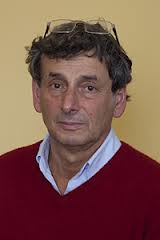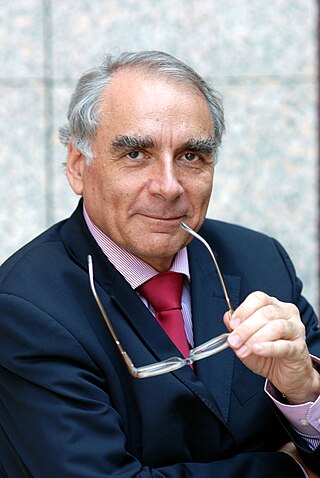
Aldo Rossi was an Italian architect and designer who achieved international recognition in four distinct areas: architectural theory, drawing and design and also product design. He was one of the leading proponents of the postmodern movement.

The Paris Peace Treaties were signed on 10 February 1947 following the end of World War II in 1945. The Paris Peace Conference lasted from 29 July until 15 October 1946. The victorious wartime Allied powers negotiated the details of peace treaties with those former Axis allies, namely Italy, Romania, Hungary, Bulgaria, and Finland, which had switched sides and declared war on Germany during the war. They were allowed to fully resume their responsibilities as sovereign states in international affairs and to qualify for membership in the United Nations. Nevertheless, the Paris Peace Treaties avoided taking into consideration the consequences of the Molotov–Ribbentrop Pact, officially known as the Treaty of Non-Aggression between Germany and the Union of Soviet Socialist Republics, whose secret clauses included the division of Poland between Nazi Germany and the Soviet Union, the occupation of the Baltic States, and the annexation of parts of Finland and Romania. The Molotov–Ribbentrop Pact changed the borders agreed after the Paris Peace Conference (1919–1920), and was signed on August 23, 1939. One week later, World War II started with Nazi Germany's invasion of Poland, followed three weeks later by the Soviet invasion of Poland, which was completely erased from the map. In the following years, Nazi Germany and the Soviet Union changed the borders established by the peace treaties at the end of World War I.

Friuli-Venezia Giulia is one of the 20 regions of Italy and one of five autonomous regions with special statute. The regional capital is Trieste on the Gulf of Trieste, a bay of the Adriatic Sea.

Gorizia, colloquially stara Gorica 'old Gorizia' to distinguish it from Nova Gorica, is a town and comune (municipality) in northeastern Italy, in the autonomous region of Friuli-Venezia Giulia. It is located at the foot of the Julian Alps, bordering Slovenia. It is the capital of the Regional decentralization entity of Gorizia and is a local center of tourism, industry, and commerce. Since 1947, a twin town of Nova Gorica has developed on the other side of the modern-day Italy–Slovenia border. The region was subject to territorial dispute between Italy and Yugoslavia after World War II: after the new boundaries were established in 1947 and the old town was left to Italy, Nova Gorica was built on the Yugoslav side. The two towns constitute a conurbation, which also includes the Slovenian municipality of Šempeter-Vrtojba. Since May 2011, these three towns have been joined in a common trans-border metropolitan zone, administered by a joint administration board.
The University of Trieste is a public research university in Trieste in the Friuli-Venezia Giulia region in northeast Italy. The university consists of 10 departments, has a wide and almost complete range of university courses and has about 15,000 students and 1,000 professors. It was founded in 1924.

László Lovász is a Hungarian mathematician and professor emeritus at Eötvös Loránd University, best known for his work in combinatorics, for which he was awarded the 2021 Abel Prize jointly with Avi Wigderson. He was the president of the International Mathematical Union from 2007 to 2010 and the president of the Hungarian Academy of Sciences from 2014 to 2020.

László Rátz was a Hungarian mathematics high school teacher best known for educating such people as John von Neumann and Nobel laureate Eugene Wigner. He was a legendary teacher of "Budapest-Fasori Evangélikus Gimnázium", the Budapest Lutheran Gymnasium, a famous secondary school in Budapest in Hungary.

Tibor Navracsics is a Hungarian lawyer and politician, who served as Minister of Foreign Affairs and Trade from June to September 2014. He previously served as Minister of Administration and Justice between 2010 and 2014. He is a member of the Christian Democratic People's Party and was the European Commissioner for Education, Culture, Youth and Sport in the Juncker Commission. Since 2022, he has been the Minister of Regional Development of Hungary.

Marta Verginella is a Slovenian historian from the Slovene minority in Italy in Trieste, notable as one of the most prominent contemporary Slovene historians. Together with Alenka Puhar, she is considered a pioneer in the history of family relations in the Slovene Lands.

Darko Bratina was an Italian sociologist, film theorist and politician of Slovene ethnicity. Between 1992 and 1997, he served as member of the Italian Senate.
Giuseppe Sacco is a tenured Italian academic specialised in international relations, with secondary interests in the fields of international economic relations, industrial and science and technology policy, international oil, the environment, and international migrations. He holds a Diplôme at the Ecole des Hautes Etudes en Sciences Sociales of the University of Paris-Sorbonne, as well as a doctoral degree in political science, University of Naples, where he also spent three years in the department of engineering. In 1966 he obtained a Fulbright scholarship at Columbia University and, early in his career, he has also been, with a Ford Foundation grant, visiting scientist at "Resources for the Future" and at the Massachusetts Institute of Technology.

The Imperial Free City of Trieste and its Territory was a possession of the Habsburg monarchy in the Holy Roman Empire from the 14th century to 1806, a constituent part of the German Confederation and the Austrian Littoral from 1849 to 1920, and part of the Italian Julian March until 1922. In 1719 it was declared a free port by Emperor Charles VI; the construction of the Austrian Southern Railway (1841–57) turned it into a bustling seaport, through which much of the exports and imports of the Austrian Lands were channelled. The city administration and economy were dominated by the city's Italian population element; Italian was the language of administration and jurisdiction. In the later 19th and early 20th century, the city attracted the immigration of workers from the city's hinterlands, many of whom were speakers of Slovene.

Péter Érdi is a Hungarian born computational neuroscientist who now lives in Michigan, United States where he is a Henry R. Luce Professor at Kalamazoo College. In his career he wrote several books and published (co-published) many scholarly articles in the fields of Chemical kinetics, Computational neuroscience and Complex systems

Italian-Slovene relations are foreign relations between Italy and Slovenia.
Gabor Batonyi is a Hungarian historian who has published numerous historical articles.

Giorgio Pacifici is an Italian sociologist.

Tibor Frank was a Hungarian historian who was professor of history at the School of English and American Studies of the Faculty of Humanities of the Eötvös Loránd University (ELTE). He was director of its School of English and American Studies. From 2013 he was corresponding member of the Hungarian Academy of Sciences (MTA), as of 2019 he was a full member.

Elena Esposito is an Italian sociologist who works in the field of social systems theory. She teaches general sociology at Bielefeld University (Germany) and prediction and the future of public policy at the University of Bologna (Italy). Her research is embedded in Luhmannian social systems theory.
Elena Brambilla was an Italian historian.

György Csepeli is a Hungarian social psychologist, sociologist, politician, professor emeritus at the Eötvös Loránd University (ELTE), former Under Secretary of State for Political Affairs at the Ministry of Information of Hungary. His research, books, papers and talks focus on antiziganism, antisemitism and foundational problems of information society and social psychology.
















